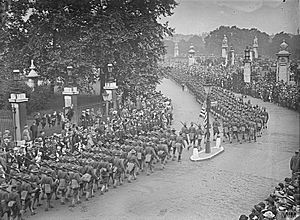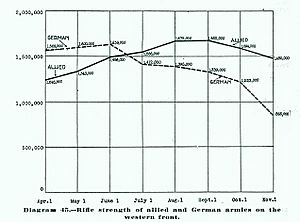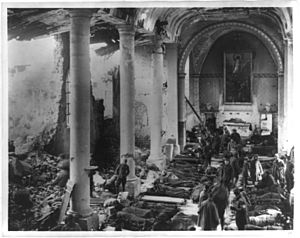American Expeditionary Forces facts for kids
Quick facts for kids American Expeditionary Forces |
|
|---|---|
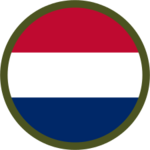
G. H. Q. Distinctive Cloth Insignia
|
|
| Active | 1917–1920 |
| Country | United States |
| Branch | United States Army |
| Role | Command and control |
| Size | 2,057,675 men (1918) |
| General Headquarters | Chaumont, France |
| Nickname(s) | A. E. F. |
| Engagements | World War I |
| Disbanded | August 31, 1920 |
| Commanders | |
| Commander in Chief | General of the Armies John J. Pershing |
| Commander of the Services of Supply | Major General Francis J. Kernan |
| Chief of the Army Air Service | Major General Mason M. Patrick |
The American Expeditionary Forces (A. E. F.) was a large group of American soldiers who fought in World War I. They were sent to the Western Front in France. The A. E. F. was created on July 5, 1917. It was led by Major General John J. Pershing.
These American soldiers fought alongside armies from France, Britain, Canada, India, New Zealand, and Australia. They faced the German Army. A small number of A. E. F. troops also helped the Italian Army fight against the Austro-Hungarian Army in 1918. The A. E. F. played a key role in important battles. These included the Battle of Château-Thierry, the Battle of Belleau Wood, the Battle of Saint-Mihiel, and the Meuse-Argonne Offensive.
Contents
Forming the A. E. F.
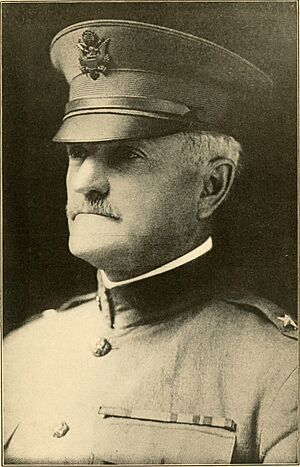
President Woodrow Wilson chose Major General John J. Pershing to lead the A. E. F. in May 1917. Pershing stayed in command for the rest of the war. He insisted that American soldiers get good training before going to Europe. Because of this, not many troops arrived before January 1918.
Pershing also wanted American forces to fight as their own army. He did not want them to just fill gaps in the French and British armies. This idea was not always popular with other Allied leaders. They worried about an army that had little experience in large-scale battles.
By June 1917, only 14,000 American soldiers were in France. The A. E. F. had only a small part in fighting until late October 1917. But by May 1918, over one million American troops were in France. About half of them reached the front lines.
Getting so many troops to Europe was a huge challenge. The U.S. Army used passenger ships, seized German ships, and borrowed Allied ships. Soldiers sailed from ports like Hoboken Port of Embarkation in New York and New Jersey. They also left from the Newport News Port of Embarkation in Virginia.
In France, the ports of Bordeaux, La Pallice, Saint Nazaire, and Brest became key entry points. From there, troops and supplies traveled by train to the Western Front. American engineers in France built many new ship berths and miles of railway tracks. They also set up thousands of miles of telephone and telegraph lines.
The first American troops, often called "Doughboys," arrived in Europe in June 1917. The A. E. F. first saw combat on October 23, 1917. The 1st Division fired the first American shell towards German lines. This group of regular soldiers entered the trenches near Nancy, France.
Supporting the Troops
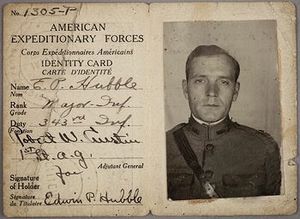
Supporting two million soldiers across the Atlantic Ocean was a huge task. The Americans had to create a strong support system from scratch. This system was called the Services of Supply. It handled everything behind the front lines. This included ports, railroads, supply depots, and maintenance facilities. They even had bakeries and clothing repair shops.
The Services of Supply developed new ways to support the army. These methods were used for many years, even into the Cold War. They included things like forward maintenance and field cooking. This work helped the A. E. F. succeed and made the American Army a modern fighting force.
African American Soldiers
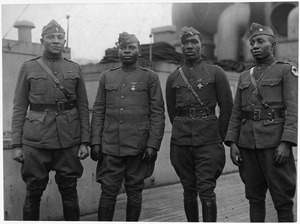
African Americans were drafted into the army like white soldiers. They made up 13 percent of all draftees. By the end of the war, over 350,000 African Americans had served in the A. E. F. on the Western Front. However, they were placed in separate units led by white officers.
Many black soldiers were assigned to labor tasks. They worked as stevedores (loading and unloading ships) and general laborers. The French Army, however, asked for and received several regiments of black combat troops.
The 369th, 370th, 371st, and 372nd Infantry Regiments fought bravely under French command. The French treated these soldiers with more respect than some American officers. These African-American soldiers wore American uniforms but used French helmets and French rifles.
One famous unit was the 369th Infantry Regiment, known as the Harlem Hellfighters. They were on the front lines for six months, longer than any other African-American regiment. Many members of the 369th received awards. Sergeant Henry Johnson was awarded the French Croix de guerre. He later received the Medal of Honor after his death.
A. E. F. Actions in World War I
In the spring of 1918, four U.S. divisions were ready for battle. They were placed under French and British command to gain experience. Their first offensive action was the Battle of Cantigny on May 28, 1918. The U.S. 1st Division won this battle. The 2nd Division also had a local success at Belleau Wood starting June 6.
After these early successes, more American troops arrived quickly. By June, about 10,000 Americans were arriving each day. Most of them trained with experienced British, Canadian, and Australian officers. This training took at least six weeks because the American soldiers were new to large-scale warfare.
The first major operation involving U.S. troops was the Battle of Hamel on July 4, 1918. About 1,000 men from the 33rd Division fought with the Australian Corps. This battle showed how different military forces could work together. It combined artillery, tanks, infantry, and air support. This became a model for later Allied attacks.
U.S. Army and Marine Corps troops helped stop the German advance towards Paris. This happened during the Second Battle of the Marne in June 1918.
The first major American-led offensive was the Battle of Saint-Mihiel in September 1918. General Pershing commanded the U.S. First Army. This army had seven divisions and over 500,000 men. It was the largest offensive operation ever by U.S. forces at that time.
This success was followed by the Meuse-Argonne offensive. It lasted from September 26 to November 11, 1918. Pershing commanded over one million American and French soldiers. In these two operations, Allied forces took back a lot of French land from the German army. By the time the World War I Armistice ended fighting on November 11, 1918, the American Expeditionary Forces had become a strong, battle-tested army.
Near the end of the war, some American units fought in other places. Pershing sent troops to Italy. President Wilson also sent some troops to Russia. These groups were known as the American Expeditionary Force Siberia and the American Expeditionary Force North Russia.
Casualties
The A. E. F. had about 320,000 casualties. This included 53,402 deaths from battle and 63,114 deaths from other causes. About 204,000 soldiers were wounded. The 1918 influenza pandemic was a major cause of non-combat deaths. It took the lives of over 25,000 A. E. F. soldiers in the fall of 1918. Another 360,000 became very sick.
Demobilization
After the war ended on November 11, 1918, thousands of Americans were sent home. By July 27, 1919, most soldiers had been discharged. Only about 745,845 members of the A. E. F. remained.
A. E. F. University at Beaune
The A. E. F. set up a university in Beaune, France. It was called the American Expeditionary Forces University. It even had its own chapter of Phi Beta Kappa, an honor society. Famous people like Walter M. Chandler, a politician, and botanist Edwin Blake Payson taught there.
See Also
 In Spanish: Fuerza Expedicionaria Estadounidense para niños
In Spanish: Fuerza Expedicionaria Estadounidense para niños
- Bonus Army
- Formations of the United States Army during World War I



